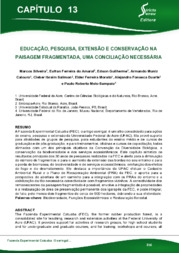Educação, pesquisa, extensão e conservação na paisagem fragmentada, uma conciliação necessária.
Educação, pesquisa, extensão e conservação na paisagem fragmentada, uma conciliação necessária.
Summary: A Fazenda Experimental Catuaba (FEC), o antigo seringal, é um sítio consolidado para ações de ensino, pesquisa e extensão da Universidade Federal do Acre (UFAC). Ela provê suporte para atividades de grupos de pesquisa, para estudantes do ensino médio e de cursos de graduação e de pós-graduação, e para treinamentos, oficinas e cursos de capacitação, todas alinhadas com um dos principais objetivos da Convenção da Diversidade Biológica, a conservação da biodiversidade e dos serviços ecossistêmicos. Este capítulo sintetiza os resultados principais dos 30 anos de pesquisas realizadas na FEC e alerta para a diminuição do número de fragmentos e para o aumento da extensão das bordas no seu entorno e para a perda de biomassa, de biodiversidade e de serviços ecossistêmicos, em função dos efeitos do fogo e do desmatamento. Ele destaca a importância da UFAC efetuar o Cadastro Ambiental Rural e o Plano de Recuperação Ambiental (PRA) da FEC, e aponta para a perspectiva de abertura de um caminho para a integração com os PRAs do entorno e a viabilização da tão necessária conectividade com fragmentos vizinhos. A conectividade dos remanescentes da paisagem fragmentada é possível, envolve a integração de propriedades e a restauração de área de preservação permanente dos igarapés da FEC, e pode integrar, de fato, pelo menos dois fragmentos de cerca de 900 hectares, dobrando a sua efetividade. The Fazenda Experimental Catuaba (FEC), the former rubber production forest, is a consolidated site for teaching, research and extension activities at the Federal University of Acre (UFAC). It provides support for activities of research groups, for high school students and for undergraduate and graduate courses, and for training, workshops and courses, all aligned with one of the main objectives of the Convention on Biological Diversity, the conservation of biodiversity and ecosystem services. This chapter summarizes the main results of the 30 years of research carried out at FEC and presents warnings and concerns of the decrease in the number of fragments and the increase in the extent of the edges in its surroundings and the loss of biomass, biodiversity and ecosystem services due to the effects of fire and deforestation. It also highlights the importance of UFAC making the Rural Environmental Registry and the Environmental Recovery Plan (PRA) of the FEC, and points to the prospect of opening a path for integration with the surrounding PRAs and enabling the much needed connectivity among neighboring fragments. The connectivity of the remnants of the fragmented landscape is possible and it involves the integration of properties and the restoration of the permanent preservation area of the FEC streams, and can in fact integrate at least two fragments of around 900 hectares, doubling their effectiveness.
Publication year: 2020
Types of publication: Book sections
Unit: Embrapa Acre
Observation
Some of Embrapa's publications are published as ePub files. To read them, use or download one of the following free software options to your computer or mobile device. Android: Google Play Books; IOS: iBooks; Windows and Linux: Calibre.
Access other publications
Access the Agricultural Research Database (BDPA) to consult Embrapa's full library collection and records.
Visit Embrapa Bookstore to purchase books and other publications sold by Embrapa.

